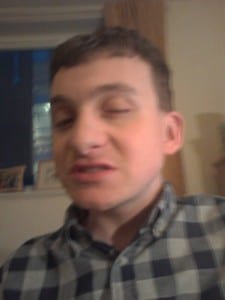After completing my final solo performance I thought I presented the emotion of loss incredibly well. Successful areas of my presentation where firstly the way I entered the performance space. I entered rather slowly due to this , the audience were able to clearly see my state of mind before the thoughts enter it. It displays that this process happens a great deal. I furthermore used the space well when I entered and sat down, I took a breath before getting dressed. My expression was one of hope and exhaustion , the reality of being faced with a working day after past traumatic experiences.
In addition, I coped with my emotions very well, not exaggerating any or demonstrating my moods. Instead, I tried to ignore the voice at times and continue with tasks, and continued in this manner until I couldn’t proceed, racing through activities to attempt to stop the voice. Although it was an accidental happening, when I was having a shave the razor blade fell off. I reacted to this naturally, as the incremental losses took control of my life more and more, and psychological stress took it’s toll,. There was then a period of time in which I spoke about the severe losses of life, and in which I broke down, and silently looked for things to do to combat the loss , and eventually gave up , my body weighing down on me. This was done very naturalistically and with eye contact with the audience at all times . However, this didn’t linger and so there were no pauses but the normal everyday structure was broken, a successful point of my performance.
Thirdly, the process of finding the props onstage was realistically performed as I searched as though I didn’t know where they were in my distracted state . My facial expressions also lent themselves well to this,. They stopped me from demonstrating, as I tried to keep my facial expressions expression, displaying that until the loss surrounded me , the activity kept me busy, and the emotions were screaming in my head, not in the situation. To aid me in this I clearly worked out my problems in my head, and invited the audience to share in this. This supported the audience in following my journey whilst again keeping the situation real. The posture, too seemed to contribute well to anxiety , depicting a normal routine that is ruined by psychological stress.
Finally, the technical elements impacted very well on my performance. The monologue itself was very clear and expressed feelings with beautiful language. I never specified any of losses making the generalization to everyone greater, and I also performed this and the tasks as a rhythm , displaying an interesting pattern for the audience. The microphone technique was excellent, as no blasting or popping were apparent plus the amount of information on each of the losses was written and recorded with potent realism. An individual would naturally want to express less about the loss of a loved one than of a wallet, at which they rant furiously. Amalgamating with this , the lighting was simple and effective, displaying the time of day very well, and giving the audience time to adjust to the situation. Lastly, I used many props to decorate the scene as a bedroom, which lent itself very well to imagining the room realistically. It also operated on a metaphorical level, reflecting the mind’s state, cluttered.
On a negative note, however, there were many things I could have improved on within my performance. Firstly, I should have reacted to the monologue with a more gradual reaction at the start, as it looked slightly melodramatic. I needed to focus my mind away from the language of the monologue as it seemed that in that first reaction I was demonstrating the thoughts . As I processed through the monologue I also looked down , and not at the audience enough. Thus, my eye level wasn’t connected to the audience and the audience weren’t to the character and performance as much as I could have . Due to this habit, I didn’t look in the mirror enough. The mirror is a device in which I can showcase my reactions and interact with myself and my emotions more. I tended to play everything upstage so didn’t stand in front of the mirror , and examine myself enough, instead motoring through the activities. Furthermore, when I did stand next to the mirror I lost concentration on the performances slightly.
Further to this, I could have improved on my transitions of emotional states. I had a long atmosphere of me coping well and not letting the loss bother me, and this was too unrealistic. To develop on this I should have portrayed more subtle states in which my mind is racing in trying to complete the activities but my body is full of exhaustion , instead of completing the activities to the best of my ability. Towards the end of the performance, I paused in one place on the stage for too long, and dithered between different moments, almost as though unsure what to do. This was acceptable for a time but this state continued for too long . I should have used the space more to travel to a sitting position, making more use of different levels and postures. In other words, this would ensure that I don’t stop without anything to do, and to start searching for something, instead proceed through the activity, and if the pressure gets too much, retire , or lie down , not stop and contemplate.
Final instances that need to be improved were my exit from the performance space. I should have exited slower, as the profound moment in which I look into the mirror was lost slightly. The expression and focus that I maintained for that final moment were great, but this is a sad , lingering event and so I needed to respond to it accurately. Technically, my monologue should have, in parts been delivered slower, as occasionally the pace lost some of the clarity. I also needed to project more on parts, as my voice was lost. The pauses between losses were slightly too long, especially in the conclusion. I didn’t remember to construct the final few losses as though they were one continuous thought and thus the rhythm seemed too jagged, and uncontrolled, not mirroring real life. I also , lastly, could have differentiated between different tones of voice slightly more.
To conclude I thought I would examine some of the other solo performances that I have watched, and parts which have inspired me if I was complete this task again. Shane Humberstone’s solo performance inspired through the characters he constructed, and their incorporation of the space. He mutli-roled as different characters , analyzing various issues that affected them. He brought members of the audience into the scene to be the other (silent) character He travelled between scenes as a teenage yob, to a feminine hairdresser, to a football fan, and when portraying the hairdresser he reminded me of an exaggerated version of Adrian Howells. His change of character was spontaneous and certified a different posture, body language, and emotional makeup. I could see my character undergoing different reactions in different spaces , alike to Shane. I could also imagine talking scenario’s over with members of the audience for them to receive a clearer impact on what the scenario is doing to my psychological stability.
Secondly, I was inspired by Tom Baines solo performance , in particular his method of sustaining a character. He played an aged professor taking a lecture on Preparing For Second Year at University. He sustained his posture, voice and mannerisms to display he wasn’t familiar with technology. I was also impressed with the realism of the situation, as he left the lecture to take a phone call and didn’t return. These two attributes are examples of ways I could improve my performance , sustaining emotions or motivation on a task and the realism of the situation. Steph’s stand up comedy performance inspired me in different ways . I was interested in how she entered from her set , a blanket fort Using some of Spalding Grey’s motives she debated over life experiences and even finished with a song, Here’s My CV, portraying, in comic fashion, the true reality of life after University. I could take this piece of information and turn my conscience thoughts into a song though to not exaggerate my profound performance more instead give them more rhythm.
A final inspiring performance was Jade Beastrall’s. She delivered a Shakespearean speech to the audience , then began instructing us on the actor within , addressing the actor as an empty seat. What especially inspired me in Jade’s presentation was when she used multimedia elements to display a film of her mirroring her live performance, and what was particularly captivating was when she stood in front of the projected image, and both the projection and live image became one. I could have improved on my performance by utilizing projections rather than a mirror, the projections perhaps pervading emotions. There will then be times, during the performance, in which I will cross the projections, pacing backwards and forwards for instance, and when realizing my fate, that the loss will return, merging in with the projection as one.
To conclude, this module has taught me many aspects about solo performance. I have explored a range of different solo performance styles from various solo practitioners . These practitioners have influenced my work , which has journeyed and developed to showcase one of my passions, experiences and something that is applicable to everyone. This module has aided me in the realization that solo performance is a lot more than standing there individually performing, instead investigating and fine tuning the dimensions that a solo performance can take.








